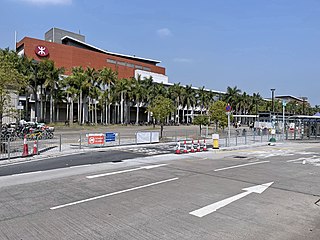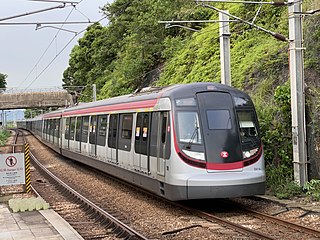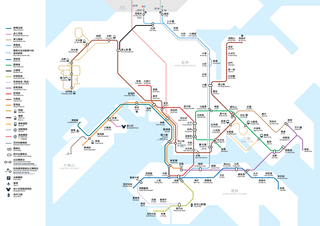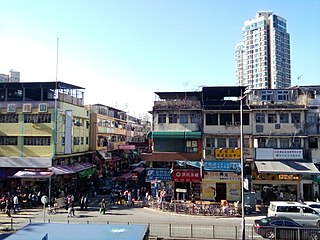
The Mass Transit Railway (MTR) is a major public transport network serving Hong Kong. Operated by the MTR Corporation (MTRCL), it consists of heavy rail, light rail, and feeder bus service centred on a 10-line rapid transit network serving the urbanised areas of Hong Kong Island, Kowloon, and the New Territories. The system included 245.3 km (152.4 mi) of rail as of December 2022 with 179 stations, including 99 heavy rail stations, 68 light rail stops and 1 high-speed rail terminus.

The tourism industry has been an important part of the economy of Hong Kong since it shifted to a service sector model in the late 1980s and early 90s. There has been a sharp increase of domestic tourists from Mainland China following the introduction of the Individual Visit Scheme (IVS) in 2003.

The West Rail line was a rapid transit line that formed part of the Mass Transit Railway (MTR) system in Hong Kong until 27 June 2021. Coloured magenta on the MTR map, the line ran from Tuen Mun to Hung Hom, with a total length of 35.7 kilometres (22.2 mi), in 37 minutes. The railway connected the urban area of Kowloon and the new towns of Yuen Long, Tin Shui Wai and Tuen Mun in the northwestern New Territories.

Kam Sheung Road is an MTR station on the Tuen Ma line, located between Pat Heung and Kam Tin in Hong Kong. It is situated between Tsuen Wan West and Yuen Long stations. Kam Sheung Road was the arena for the KCR West Rail's opening ceremony.

The East Rail line is one of the ten lines that form MTR, the mass transit system in Hong Kong. The railway line starts at Lo Wu or Lok Ma Chau, both of which are boundary crossing points into Shenzhen and joins in the north at Sheung Shui and ends at Admiralty station on Hong Kong Island. At approximately 46 km (29 mi), the line is the second longest line within the network, behind the Tuen Ma line. The line's colour is light blue.

Sheung Shui is the penultimate northbound station on the East Rail line in Hong Kong. This station serves as the northern terminus of the East Rail line after the Lo Wu and Lok Ma Chau boundary crossings have closed for the day. It is also the last northbound station on the East Rail line that passengers without a Closed Area Permit, Mainland Travel Permit, or valid passport and mainland Chinese visa may freely travel to.

Sheung Shui is an area in the New Territories, Hong Kong. Sheung Shui Town, a part of this area, is part of the Fanling–Sheung Shui New Town in the North District of Hong Kong. Fanling Town is to its southeast.

Sha Tin, also spelt Shatin, is a neighbourhood along Shing Mun River in the eastern New Territories, Hong Kong. Administratively, it is part of the Sha Tin District. Sha Tin is one of the neighbourhoods of the Sha Tin New Town project.

Yuen Long is a town in the western New Territories, Hong Kong. To its west lie Hung Shui Kiu (洪水橋), Tin Shui Wai, Lau Fau Shan and Ha Tsuen, to the south Shap Pat Heung and Tai Tong, to the east Au Tau and Kam Tin (錦田), and to the north Nam Sang Wai.

Several future projects on the MTR have been put forward by the MTR Corporation to the Hong Kong Government. Some of these are still in planning stage.

The 2008 Chinese milk scandal was a significant food safety incident in China. The scandal involved Sanlu Group's milk and infant formula along with other food materials and components being adulterated with the chemical melamine, which resulted in kidney stones and other kidney damage in infants. The chemical was used to increase the nitrogen content of diluted milk, giving it the appearance of higher protein content in order to pass quality control testing. 300,000 affected children were identified, among which 54,000 were hospitalized, according to the latest report in January 2009. The deaths of six babies were officially concluded to be related to the contaminated milk.

Relations between people in Hong Kong and mainland China have been relatively tense since the early 2000s. Various factors have contributed, including different interpretations of the "one country, two systems" principle; policies of the Hong Kong and central governments to encourage mainland visitors to Hong Kong; and the changing economic environment. More broadly, there exists resentment toward mainland-Hong Kong convergence and assimilation, as well as the increasing interference from the government of China and its ruling Chinese Communist Party (CCP) in Hong Kong's internal affairs.

The 2015 Yuen Long protest, called Liberate Yuen Long or Recover Yuen Long by the protesters, was part of a series of anti-parallel trading protests in the northern districts of Hong Kong that took place on 1 March 2015 in Yuen Long. It was mainly organised by Civic Passion, Hong Kong Indigenous and groups from social media and local residents. The protesters rallied against the parallel traders who buy goods in Hong Kong, especially in Yuen Long, and sell them in Mainland China for profit.

Anti-parallel trading protests took place in Hong Kong between 2012 and 2015, and again in 2019, against parallel traders importing goods from Hong Kong to Mainland China. Protestors claim that parallel trading has caused a shortage of household goods and an increasing inflation rate. Parallel trading and the protests have exacerbated the Hong Kong-Mainland conflict. There has also been conflict between local shop owners and citizens as the parallel trading boosts shop sales but raises the local prices of daily necessities.
Reclaim Sheung Shui Station was a series of social movements which took place at Sheung Shui MTR station from 15 to 18 September 2012. The protests were a response to the smuggling and parallel trading problem in Hong Kong.

Ray Wong Toi-yeung is a Hong Kong activist. He founded the localist camp Hong Kong Indigenous with other activists who were dissatisfied with the efficacy of Hong Kong's mainstream democratic movement during the 2014 Hong Kong protests. He took an active part in the Mong Kok civil unrest on Lunar New Year's Day 2016 and was arrested later that month.

Shek Wu Hui is a non-administrative subdivision (neighbourhood) and former indigenous market town located in Sheung Shui in the North District of Hong Kong. The place name can be found in the record that published in 1819.

Hong Lok Yuen is a low-density luxury residential housing estate in Tai Po District, New Territories, Hong Kong, located near Cloudy Hill. It is north of Tai Po Town.

Luo Changqing, a 70-year-old Hong Kong cleaner, died from head injuries sustained after he was hit by a brick thrown by a Hong Kong protester during a violent confrontation between two groups in Sheung Shui, Hong Kong on 13 November 2019. Following his injuries, he was taken to Prince of Wales Hospital, Sha Tin, where he died the next day. This incident was described as the first fatality directly attributed to the Hong Kong protests that began in 2019.





















